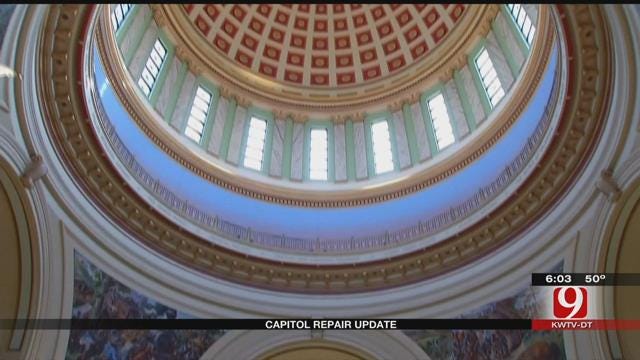Governor Asks For $120 Million To Help Restore Capitol Building
<p>The legislature has already agreed to find $120 million in repairs.</p>Friday, February 5th 2016, 3:59 pm
During her State of the State Address, Governor Mary Fallin called for an additional $120 million in bonds to repair the State Capitol Building. That’s on top of the $120 million already allocated. But does the building really need that much work?
From a distance it looks pretty good. But when you get closer, you can notice cracks in the concrete, exposed rebar, and cracks in the basement floor. That’s caused by cracks in century old sewage pipes that will have to be dug up and replaced.
“For decades those pipes have been failing and leaking into the ground,” said John Estus with Oklahoma Management & Enterprise Services. “Those are things coming from the bathrooms and all leaking up here. You can see some of the cracking.”
Kyle Nelson of Manhattan Construction, one of the firms working on the building, said the pipes are virtually useless.
“Waste sewage is running almost on dirt because the underside of this piping that is a century old has completely decayed. You can poke a pencil right through it and it is part of the infrastructure restoration,” said Nelson.
Much of that will be replaced using the existing $120-million allocation. The additional money, if approved by the legislature, will be used to extend pipes to other areas of the Capitol for a fire sprinkler system and to bring electrical wires to rooms throughout the building. Many of the wires are a hundred years old, and the electrical system is on its last legs.
“All of this equipment is 40 or 50 years old, (It’s) long past its useful life for the building,” said State Capitol Project Manager Trait Thompson.
The new money would also be used for improvements to the outside of the building that you probably wouldn’t see unless you were really looking for it, like crumbling mortar and the window frames slowly rusting away.
“About 40% of the copper roof needs to be replaced. The doors all the way around the building are rusted and warped. They need to be replaced,” said Thompson.
Those working on the project say it will save money to do all of the work in one fell swoop rather than bringing contractors back over and over again, doing the project a little at a time. And, after years of shoddy repairs, they say it’s time to do the project right while maintaining the historical integrity of the building.
“The building was finished in 1917 and it was designed by 1917 standards and it’s a beautiful building”, Thompson said, “We need to combine that beauty with functionality going forward.”
Project managers say they can’t promise this will be their last request for money. They just don’t know what other problems may come up as the restoration continues. They do say the bonds for the project won’t have any effect on the 2017 budget, and by the time those bonds have to be paid down; other bonds will have been paid off. So, they say, it’s kind of a financial wash.
More Like This
February 5th, 2016
November 13th, 2024
October 28th, 2024
October 17th, 2024
Top Headlines
December 25th, 2024
December 25th, 2024
December 25th, 2024













